I’m laying in bed holding my breath. After 10 seconds, I take a deep exhale, blowing a steady stream of air through my lumen device. After a few seconds, a color-coded 1 to 5 scale pops up on my screen.
It says I’m currently #4. I’m burning 60 to 80% carbs for energy.
“What the hell,” I say out loud. “I haven’t eaten any carbs today. In fact, I haven’t eaten carbs in days.”


I had cut out most carbs following Lumen’s dietary recommendations in an attempt to bring my score back into fat-burning mode (a 1 or 2 on their scale). Yet days later, I still couldn’t get a number below 3.
“This doesn’t make any sense,” I remarked.
Meanwhile, my wife took the same inhale, breath-hold, and exhale into her own lumen device. She waited a moment for lumen to give her a score…#2. She was burning 60 to 80% fat.
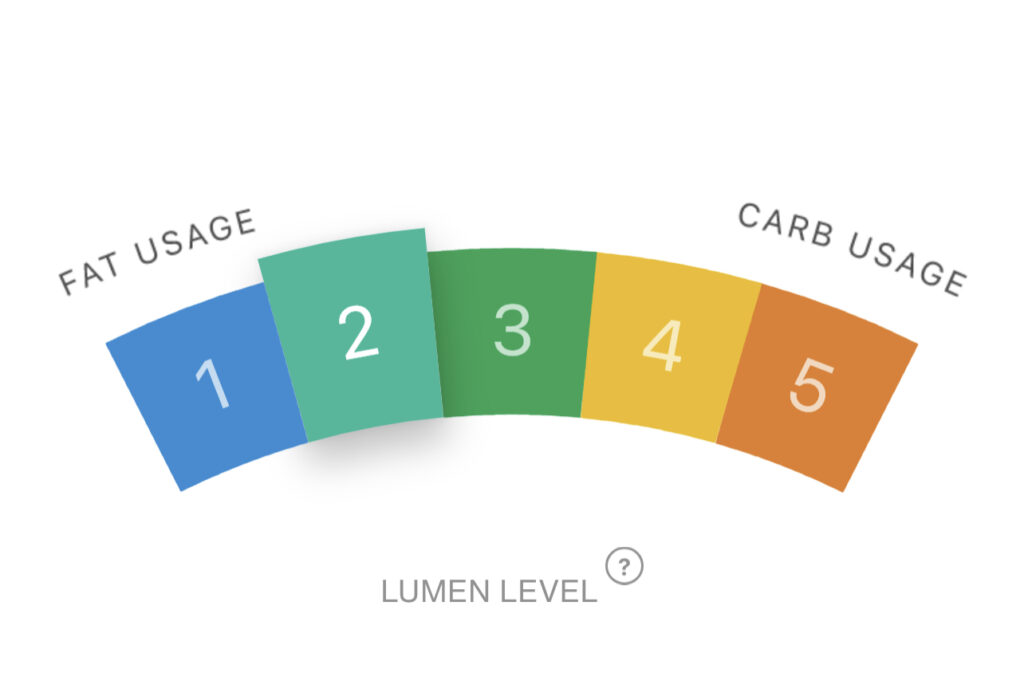

“What the hell,” she says. “I don’t get it.” She had carbs with dinner the night before and she was somehow burning fat instead of sugar.
Both of us sat there perplexed by these numbers. They didn’t seem to reflect our diet. Nor did they seem to reflect the basic premise that your body will primarily burn the fuel you feed it.
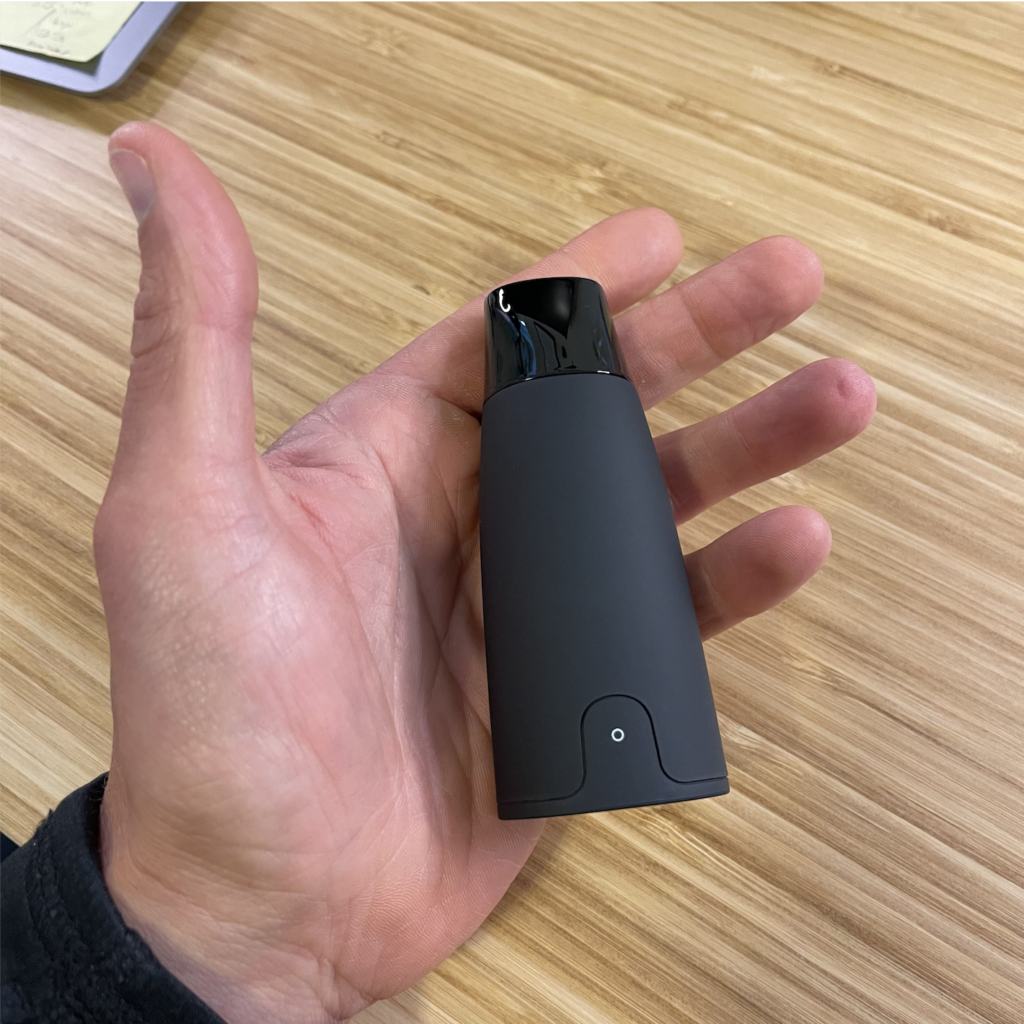

Enter: Metabolic Flexibility
The idea that your body can adjust its fuel back and forth from burning fats to burning carbs is known as “Metabolic Flexibility.”
The basic theory is that if you eat a lot of carbs, your blood sugar goes up and insulin is released to pull sugars into your cells. Once in your cell, these sugars can be utilized for energy.
Conversely, if you limit carbs and keep your insulin low, your body will shift to burn fats for energy.
Unfortunately, the gap between theory and reality can be huge when it comes to an enormously complex system like your body.
What Lumen Actually Measures
The Lumen measures your breath and calculates your respiratory exchange ratio (RER), the ratio between the metabolic production of carbon dioxide (CO2) and the uptake of oxygen (O2). This ratio can be used as an indicator of which fuel (e.g. carbohydrate or fat) is being metabolized to supply the body with energy.
As my wife and I were learning, interpreting your RER isn’t always straightforward. There are a number of factors that influence how much CO2 you exhale.
- Lumen is only accurate when you have been resting for a while. Any exercise or movement that elevates your heart rate will throw it off. In fact, it will often tell you to take a few minutes to sit if it has detected you’ve been moving around before taking a reading.
- What you put into your body is only one part of the metabolic flexibility equation. Cutting out carbs is the obvious place to nudge your metabolism towards burning fat, but your daily physical activity, sleep, stress, gut microbiome, and hormone fluctuations play a big role in determining what is fueling your cells.
- Even if Lumen can accurately measure and track your metabolic flexibility, it cannot be used in isolation. To truly understand why your body is using carbs or fats requires looking at a number of metabolic markers. You need to consider the following:
- Is your body regulating blood sugar properly?
- Do you have normal cortisol rhythms?
- Is your thyroid functioning optimally?
- Do you have chronic inflammation?
- Is your gut microbiome balanced?
- Are you insulin resistant?
- Do you have any nutrient deficiencies?
- What medications are you taking?
Unraveling this metabolic picture takes a lot of investigative work. This is both the challenge and opportunity of a functional, integrative approach toward improving your hunger, energy, and health.
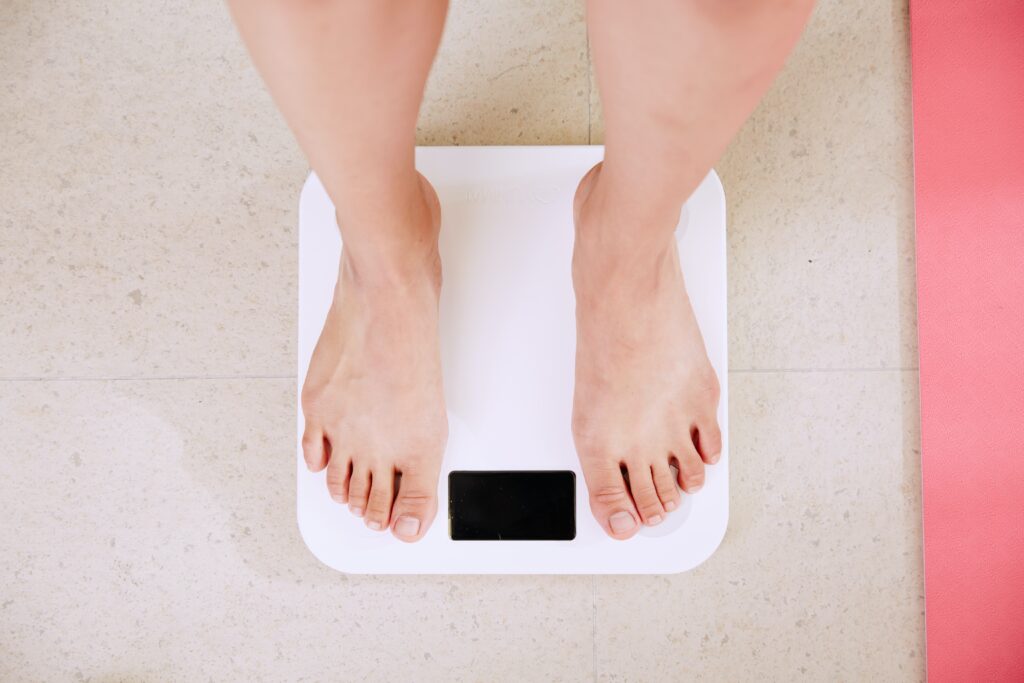

Why Your Metabolic Fuel Matters
If you truly care about staying fit for the long run, figuring out if you are metabolically flexible is important for two main reasons:
1. Weight Management & Metabolic Flexibility
When it comes to managing weight, efficiently burning fat helps your body manage daily fluctuations in calorie intake and expenditure. The oversimplified version goes like this: If you eat more than you need, your body will store the extra calories as fat to be used later when you’re in a calorie deficit. However, when you lose your ability to tap into fat stores as an energy source then your body is forced to rely heavily upon stored sugars that lead to hunger and energy rollercoasters.
People who are “fat adapted” — metabolically flexible enough to burn fat as default — tend to have few hunger pangs, cravings, or energy crashes during the day. According to the Lumen website, Lumen helps you improve your body’s ability to burn fat which decreases your hunger levels and makes your body less dependent on snacking.
Why Does Burning Fat Impact Hunger?
Fat is like a big log on the bottom of the fire. It burns slowly and steadily for a long time. Carbs, on the other hand, are like kindling. They create a nice big flame but are gone in minutes. If you want to feel satiated, you need to ensure there are enough big logs on the fire.
Calorically speaking, if you imagine a car pumped up with these two fuels, fat would give you 9 miles per gallon, sugar only 4. Which one would you choose to run your car on?
Using stored fat is a more efficient fuel source: an evolutionary adaptation to provide plenty of energy reserves when food is scarce.
However, we live in a world where food is not scarce. The standard American diet is characterized by:
- Eating too often (too much snacking)
- Eating too much (too many daily calories)
- Eating too many sugars (too many blood sugar spikes)
This mismatch between our evolutionary design and our modern food environment is a big problem for our health. It has undermined our body’s ability to effectively manage day-to-day changes in food availability. The overconsumption of calories, increased sedentary lifestyle, and other environmental factors like lack of natural sunlight, have disrupted our body’s ability to use fat as a primary fuel source for daily activities.
In fact, a study from the American Journal of Physiology found that metabolically inflexible individuals accumulated ∼200 g more fat than flexible subjects after one week of eating a high-fat diet (60% of total energy). Conversely, those who were metabolically flexible were better able to adapt to dietary changes and use the fat as a fuel source rather than store it.
The short story is if you want to lose or maintain a healthy body weight, optimizing your body’s ability to burn fat is one important piece of the puzzle.


2. Metabolic Flexibility & Overall Health
The inability to switch between burning fat and burning sugar at the cellular level has been implicated in a number of diseases. In fact, growing research points to metabolic inflexibility as a driver of insulin resistance and other disorders like obesity and diabetes.
It’s not that sugars are necessarily bad. They’re a great source of quick energy. But different organs prefer different blends of fuel. A healthy heart, for instance, runs on about 70% fat and 30% sugar to keep it beating. People with various pathological heart conditions will see a shift in cardiac metabolism towards burning more sugar. In this way, measuring and tracking the metabolic flexibility of different organs can serve as an early warning sign of disease.
A healthy body can burn carbs effectively, but there are consequences to eating sugars all day, every day. The main ramification of constant carb burn is an increase in inflammation.
According to the book Fat for Fuel, using sugar rather than fat for energy produces 30 to 40 percent more reactive oxygen species (ROS), also known as free radicals. These are molecules that, in excess, can cause irreversible damage to your DNA.
One way to limit ROS damage is by eating a colorful diet full of antioxidants. Another way is to ensure your cells aren’t overburdened with processing sugars all day. Numerous medical studies suggest that ROS are involved in the development of:
- Atherosclerosis
- Hypertension
- Peripheral vascular disease
- Coronary artery disease
- Cardiomyopathy
- Heart failure
- Cardiac arrhythmias.
If that isn’t a little worrisome, an inflexible metabolism is also associated with other pathological conditions including metabolic syndrome, type 2 diabetes, and cancer.
For this reason, the ability to burn fat as your default fuel and effectively switch over to using carbs as needed — what I’m referring to as being in a fat-adapted metabolically flexible state — is an important feature of good cellular health.


Essential Points To Know About Metabolic Flexibility
- Metabolic flexibility describes efficient switches in burning fat vs burning sugar.
- Metabolic flexibility can be improved through diet, exercise, and meal timing.
- Periodically reducing carbs in your diet (i.e., having low to no carb days ) along with prolonged fasting can help shift your body into fat-burning mode.
- The timing and type of exercise can also be used to help your body utilize stored sugars and train your fat-burning pathways to become more robust.
- To improve metabolic flexibility, exercise intensity, meal timing, and carb intake need to be considered together alongside your emotional stress and sleep habits for best results.
- Metabolic inflexibility is a hallmark of many metabolic diseases like insulin resistance, and diabetes. It also plays a central role in cancer.
- Metabolic inflexibility may also make it harder to lose excess fat or maintain a consistent weight.
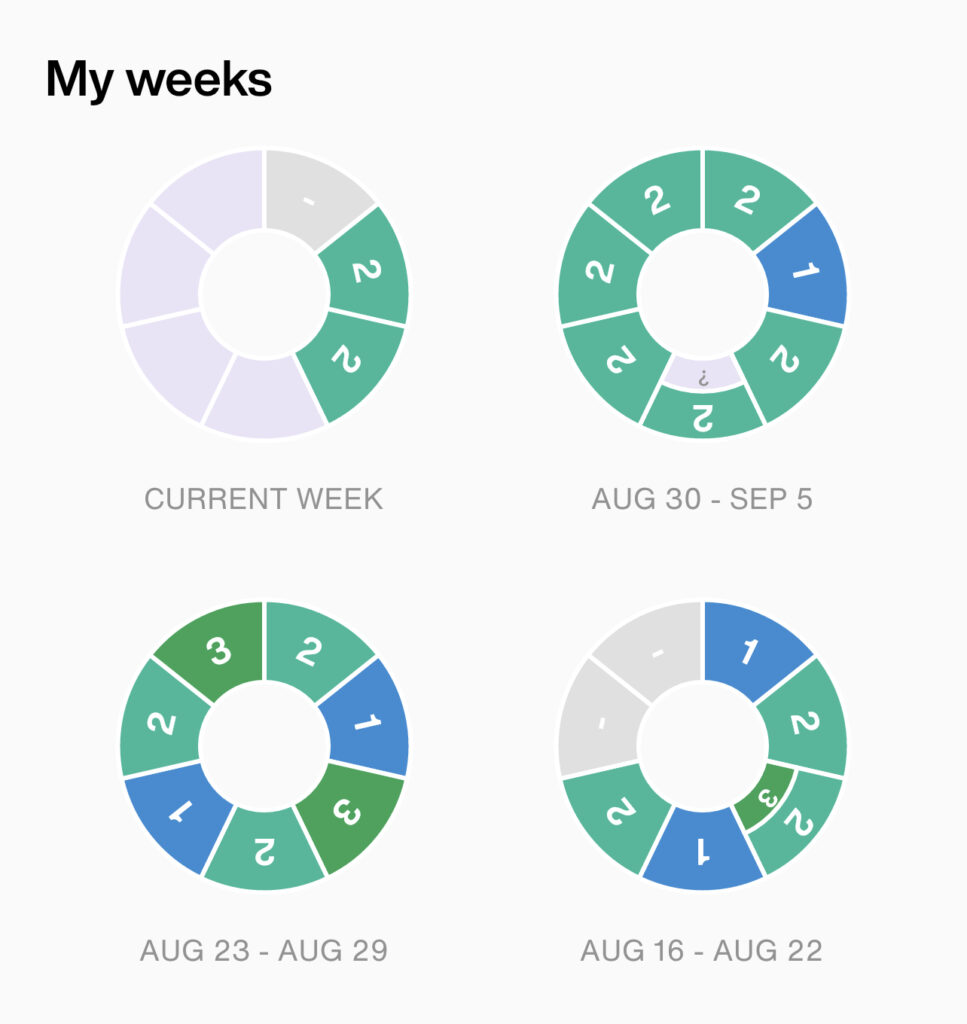

How To Make Sense of Lumen Results?
Before the Lumen gadget came around, there was no simple way to measure your metabolic flexibility. You needed to get hooked up to a bunch of gadgets in the lab that monitored your diet, respiratory gasses, and activity all day long. Not something most of us would want to do.
The lumen makes it easy to take daily measurements of what is fueling your body. But does it actually help you retain or regain your metabolic flexibility?
The answer is yes and no.
Yes, Lumen’s algorithm can instruct you to modify your carb intake based on your morning reading. The idea is that testing your breath in the morning is indicative of your default metabolic state. Ideally, after a nightly fast, your body should be in a mild fat-burning mode.
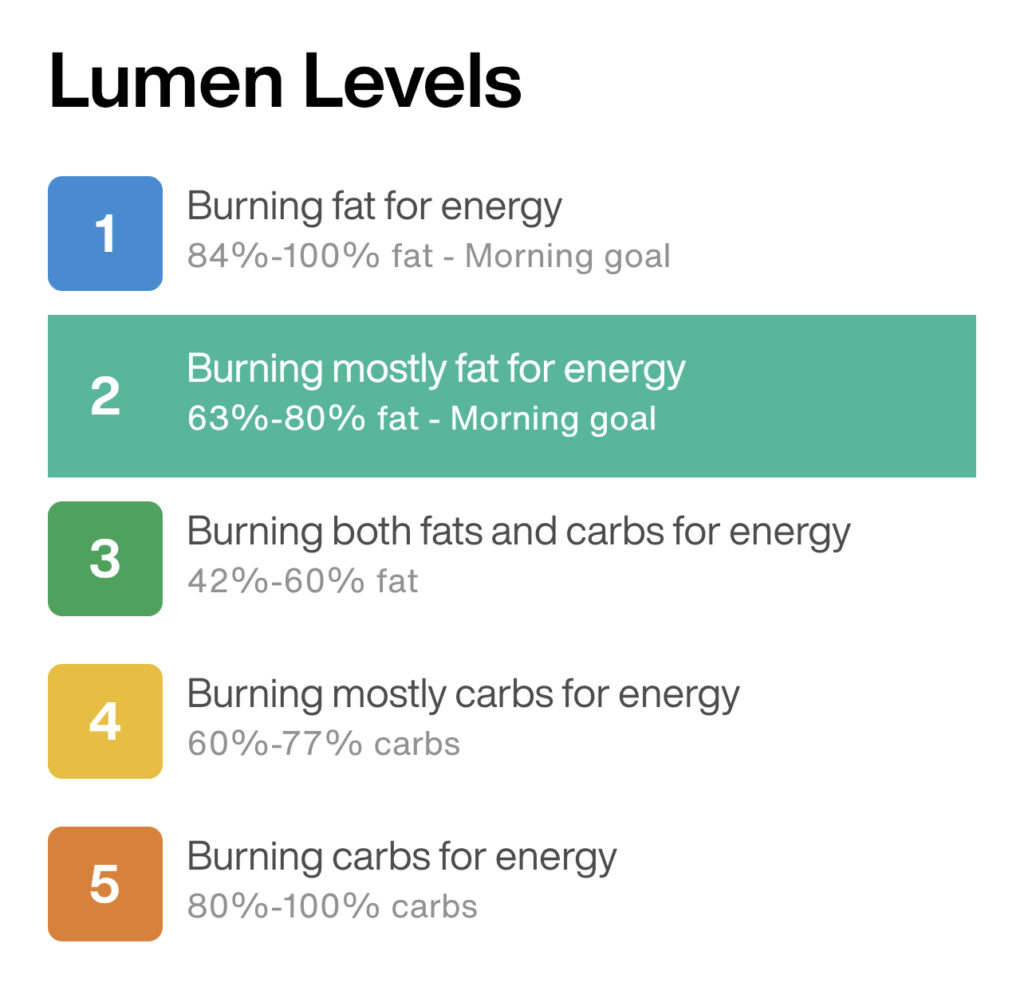

If you wake up every morning still burning mostly carbs, it’s a sign your diet isn’t optimized or you may have lost some metabolic flexibility, becoming dependent on sugars for energy.
As said before, a prolonged inability to get into fat-burning mode may be an early warning sign that your cellular health is compromised. This is parallel to waking up with elevated fasting glucose levels as a predictor of insulin resistance and an early indicator of disease.
The challenge in regaining metabolic flexibility is that modulating your carb intake is only one factor that impacts your metabolic state. Other factors in addition to how many carbs you’re eating each day include:
- When You Eat: When you consume carbs in your day (early or late at night), whether you eat them before or after exercise, and how you eat them (with protein or with fat) can change how your body processes them. Generally, carbs consumed early in the day, around exercise, and with a low-fat, high-protein meal seem to burn easier and are less likely to overwhelm your cells.
- Process vs Whole Foods: The quality of carbs still matters. Lumen suggests macros for your daily diet, but where those calories are coming from will impact your body. Highly processed carbs quickly are broken down into simple sugars that lead to blood sugar spikes that drive up inflammation. In addition, highly processed foods both require less chewing which typically leads to eating faster. When you combine this with the hyper-palatable nature of processed carbs, it becomes much easier to overeat.
- Longitudinal Measurement: Metabolic flexibility cannot be assessed by a signal measure. It can take days or weeks to get an accurate picture of whether your metabolism is effectively fuel-switching.
For all these reasons, Lumen has designed a “Flex Score” based on 4-8 weeks of measurements. Although they don’t share how they calculate this number, it is supposed to be a comprehensive evaluation of how flexible your metabolism is that gets updated each week.
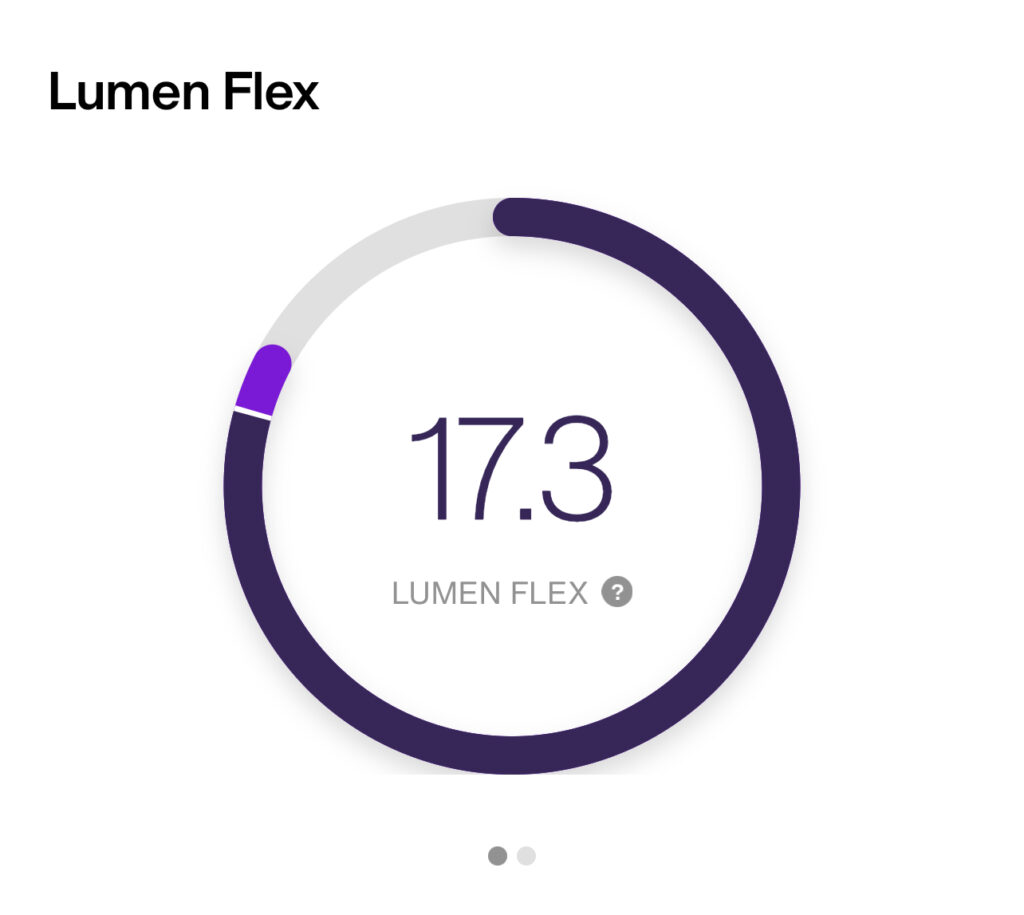

What May Disrupt Your Metabolic Flexibility
Returning back to my wife and I sitting in bed confused by our Lumen readings, it is very possible that our strange reading was an outlier as the algorithm adjusted to our bodies.
There are, however, a few good reasons why I might have been burning sugars for energy when I hadn’t eaten any carbs in days. Here are a few possible causes for a loss of metabolic flexibility and sustained carb burn:
- Metabolic Lag. Everyone’s metabolism shifts between fats and carbs at different rates. Depending on your levels of activity and calorie intake, your body may be using energy from previous meals before utilizing your latest food as a source of energy. Therefore, what you just ate might not be reflected in your Lumen score. This is especially true when alcohol is involved as your body will process those calories first in the name of detoxification before handling the other food you ate.
- Too Much Stress & High Levels of Cortisol. Cortisol gets a bad rap for being a stress hormone that promotes weight gain. While it can lead to excess belly fat, this is only true if your cortisol remains elevated for too long at the wrong times of the day. The right amount of cortisol at the right time (i.e. first thing in the morning and during intense exercise) can actually help you burn fat and stay energized.
What makes your cortisol get out of whack?
Too much stress, too many stimulants, too much exercise, not enough rest, or often, all of the above. It’s possible that my daily workout routine in combination with fasting and a low-carb diet pushed my body into a chronically stressed state.
- The solution to this specific conundrum is to reduce stress and double down on high-quality sleep. If you’re exercising a lot to lose weight, counterintuitively, the remedy may be to eat more and exercise less.
Although fasting has many benefits, some fasts may be too long and put your body in a stressed state. This seems to be especially true for women due to differences in sex hormones. When you throw lots of intense physical exercise on top of a depleted body, you will start to dysregulate your hormones. This is why sometimes the classic “eat less, exercise more” advice for weight loss can backfire. This chronic release of cortisol and its impact on blood sugar can make it harder to get into fat-burning mode.
Chronic stress in any form is going to impact your metabolic flexibility. Adopting a “rest-based lifestyle” that decenters the relentless “hurry and worry” mindset is one critical part of countering this trend. Meditation and breathwork are excellent ways to help shift your body out of a stress state and help your body regain its ability to burn fat effectively.
- Burning Stored Sugars. Despite the idea that your body is burning the food you ate today, your metabolism is actually affected by the last 3-4 days of activity and eating. Even if you’re not eating many carbs, stored sugars in the form of glycogen can be used to help meet your energy needs.
It can take days to a week to empty your sugar tank before your body switches over to fat for fuel. It is possible that even though I was very low-carb for a number of days, I still had adequate stored sugars in my liver and muscles to use as fuel.
Knowing that it can take a while to nudge your body back to fat burn might make you think twice about drinking that beer or eating a high-carb snack. Moreover, it gets you to consider your diet across your entire week rather than as an isolated meal.
The question you should ask is whether you’re constantly topping off your sugar tank or sticking with an eating plan long enough to see results. - Not Properly Counting Carbs. The elephant in the diet room is always inaccurate measurement coupled with incorrect portion control— Consuming more carbs than I thought.
Was I truly eating low-carb or just deluding myself into thinking I was cutting out sugars?
So much modern food has hidden added sugars. You need to really read nutrition labels, look at position sizes, and consider those extra little add-ons — a squirt of ketchup, a spoonful of dressing, or even a dab of hummus may have more carbs than you think.
Store-bought items like chicken salad or coleslaw, although seemingly low-carb, probably contain added sugars. Even something like a beet and walnut salad, nutritious by all means, has more sugar than you may imagine. Becoming carb conscious takes awareness and a lot of practice.
Note: I’m not demonizing carbs, only describing the challenge of accurately tracking them in service of metabolic flexibility. At the end of the day, we don’t eat macronutrients, we eat food. Real, whole, unprocessed food is still the best, regardless of its macro composition. Lionizing or demonizing any nutrient is a form of scientific reductionism that misses the bigger picture of what it means to eat well. - I Was in Ketosis. Ketogenic diets severely restrict carbohydrates and force your body to adopt a different metabolic pathway for producing energy. When your body senses that there are no more stored sugars available to burn, it produces ketone bodies that can be used as an alternative fuel source.
These ketones typically flow from your liver to your brain for use as fuel, sparing whatever sugar is left for other cellular functions. Nutritional ketosis can be incredibly helpful to train your cells to become less reliant on sugar and potentially reverse some of the consequences of insulin resistance. The catch is that the burning ketones create a different breath signature that Lumen cannot always differentiate.
In an exchange with the Lumen customer support team, they said, “At a biochemical level, the burning of ketones is not the same as burning fats. Burning ketone bodies for fuel produces more CO2 than burning fatty acids. For this reason, when you are in deep levels of ketosis, your Lumen may not clearly indicate a state of fat burn and you may see higher Lumen levels.”


Building A Better Metabolism Takes Time
After using the lumen for over two months, I can say the readings are much more in line with what I’d expect given my diet and exercise. I do believe some of the initial results may have been anomalies as the device was learning about my metabolism.
In fact, I believe Lumen has updated its calibration days to a machine learning algorithm that is supposed to get more accurate with every breath you take. That is, of course, if you tell it about your eating and exercise habits.
The app asks you how many carbs you consume each day to help it produce a customized nutrition plan. For example, if you have been eating low-carb and waking up in a fat-burning zone for multiple days, it will adjust your carb recommendations up. They call this a “Boost Day” to ensure your metabolism remains flexible.
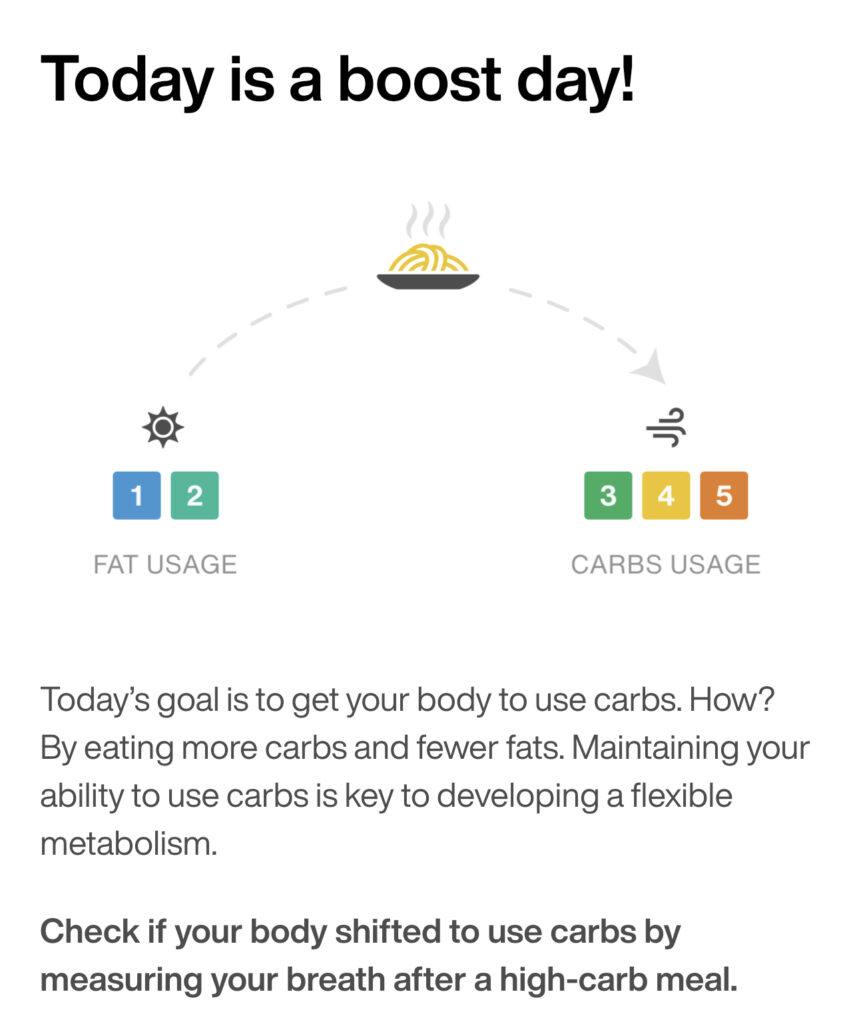

To be honest, I didn’t precisely follow the nutrition plan, but I do believe having higher and lower carb days can be helpful. Carb cycling along with meal timing can often aid in losing excess body fat and avoiding disease.
Make Metabolic Flexibility A Priority
On the whole, metabolic flexibility gives you a body that is stronger, healthier, and more resilient than an inflexible one. When your body has the ability to burn fat for fuel, it’s not only easier to control hunger cravings and lose body fat, but it also protects your DNA and cell membranes.
A flexible metabolism should allow you to process carbs without becoming overly reliant on sugars for fuel. In other words, you can have a big bowl of pasta or bread and then readily shift back to fat burn.
If that sounds like an appealing proposition, the question is should you get a Lumen?
On one hand, a few hundred dollars and a few breaths seem like a small price to pay for a device that helps you monitor and manage this flexibility.
The added value of tracking your diet and exercise makes Lumen support healthier lifestyle practices in general. It will make you think twice about what you eat. Plus, it has the unintended benefit of getting you to take a few conscious, deep breaths. Something most of us can benefit from doing more regularly.
At least one scientifically validated study says the Lumen is comparable to a lab-based metabolic test. But of course, one study should be taken lightly. Replication is the cornerstone of good science.
Therefore, even if Lumen is not perfectly accurate, it may help you become more aware of your body and what’s going on “under the hood” of your metabolism.
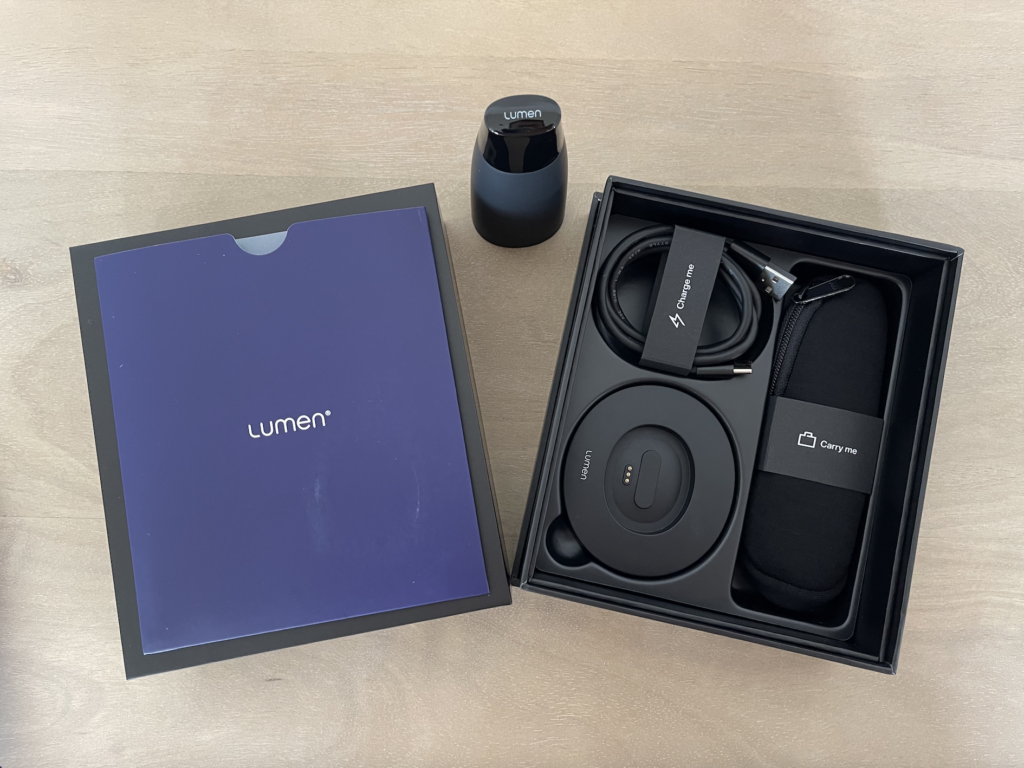

Use the Lumen Device. Don’t Let It Use You.
As with all metabolic hacking devices, they point to one important truth: the body is immensely complex.
Taking one measure, whether that be blood sugar, or in this case amount of carbon dioxide exhaled in your breath, can only tell you so much about the symphony of hormones, enzymes, neurotransmitters, and bacteria that help sustain your magical body.
My advice for using the Lumen is the same as my advice for any biohacking or fitness gadget: let it be a tool for learning about your body, not for dictating behavior.
Let Lumen guide you to pay more attention to how you feel when you wake up and after meals. But don’t get overly hung up on every reading. It’s easy to drive yourself crazy with carb control, which creates unnecessary stress that is totally counterproductive.
If using the Lumen is causing you frustration or disappointment because you’ve lost some metabolic flexibility, it might be a sign to look deeper at what is going on in your body. The reason for using such a device is not to micromanage the hell out of every aspect of your diet, but to give you a better sense of what your body is doing from the inside out.
Over time, you may be able to tell whether you’re in fat or carb-burning mode without needing a device. You can begin to feel how your diet, exercise, sleep and stress impact your energy in a really nuanced way.
In fact, I have become much better at accurately predicting what Lumen reading I will get in the morning based on how I feel and my diet and exercise over the last few days.


Technology Can Only Help If You See The Bigger Picture
Yes, smart carb control and intermittent fasting can help you build a flexible metabolism. Appropriate exercise and stress management can also play a big role in keeping your metabolism healthy.
But what is really going to transform your health is not a technological revolution, it’s a social and environmental one.
Strong relationships and time outdoors can heal your body in more ways than you might believe (granted you aren’t spending every moment outside drinking till 6 am with friends.)
Get out into nature, have a regular sleep schedule, remove toxins from your environment, and invest in supportive social connections that make you smile. These will truly bulletproof your wellbeing.
The Lumen will only help you eat smarter if you love yourself enough to believe you’re worthy and capable of change. If you don’t believe you can feel better, no amount of technology is going to help.
Technology like Lumen can help you get out of an unhealthy pattern and build bodily awareness, but it must be coupled with a belief that taking care of yourself matters.
Go forth and know thyself, one breath at a time. You’re worthy of it.
~ Jeff Siegel
PS. If you’ve made it this far, congratulation! You’re seriously invested in upgrading your health and wellness.



